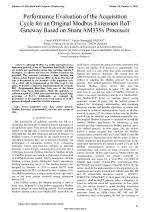| 2/2024 - 5 |
Performance Evaluation of the Acquisition Cycle for an Original Modbus Extension IIoT Gateway Based on Sitara AM335x ProcessorVENTUNEAC, C. |
| Extra paper information in |
| Click to see author's profile in |
| Download PDF |
Author keywords
acquisition cycle, base station gateway, Modbus Extension, programmable real time unit, system on chip
References keywords
modbus(18), communication(11), control(9), industrial(8), implementation(8), systems(5), fieldbus(5), technology(4), system(4), icstm(4)
Blue keywords are present in both the references section and the paper title.
About this article
Date of Publication: 2024-05-31
Volume 24, Issue 2, Year 2024, On page(s): 41 - 48
ISSN: 1582-7445, e-ISSN: 1844-7600
Digital Object Identifier: 10.4316/AECE.2024.02005
Web of Science Accession Number: 001242091800005
SCOPUS ID: 85195686061
Abstract
Although Modbus is a widely used and easy-to-implement protocol, it has its limitations. Specifically, it does not include any specification about time variables, making it incomplete. To address this issue, the Modbus Extension was proposed. This extension introduces a time variable, but requires a Base Station Gateway (BSG) to do so. The interval time is determined by the structure of the acquisition cycle (AC), which will be implemented at the BSG level. In this paper, we present a solution for implementing the AC using the PRU (Programmable Real-Time Unit) core of the Sitara AM335x from Texas Instruments. With this approach, we achieved a speed of 12 Mb/s and a payload data channel usage percentage of 53.3 %. Additionally, we evaluated the performance of the acquisition cycle in the context of an IIoT gateway developed around the AM335x processor. |
| References | | | Cited By |
Web of Science® Times Cited: 0
View record in Web of Science® [View]
View Related Records® [View]
Updated today
SCOPUS® Times Cited: 0
View record in SCOPUS® [Free preview]
There are no citing papers in the CrossRef Cited-by Linking system.
Disclaimer: All information displayed above was retrieved by using remote connections to respective databases. For the best user experience, we update all data by using background processes, and use caches in order to reduce the load on the servers we retrieve the information from. As we have no control on the availability of the database servers and sometimes the Internet connectivity may be affected, we do not guarantee the information is correct or complete. For the most accurate data, please always consult the database sites directly. Some external links require authentication or an institutional subscription.
Web of Science® is a registered trademark of Clarivate Analytics, Scopus® is a registered trademark of Elsevier B.V., other product names, company names, brand names, trademarks and logos are the property of their respective owners.
Faculty of Electrical Engineering and Computer Science
Stefan cel Mare University of Suceava, Romania
All rights reserved: Advances in Electrical and Computer Engineering is a registered trademark of the Stefan cel Mare University of Suceava. No part of this publication may be reproduced, stored in a retrieval system, photocopied, recorded or archived, without the written permission from the Editor. When authors submit their papers for publication, they agree that the copyright for their article be transferred to the Faculty of Electrical Engineering and Computer Science, Stefan cel Mare University of Suceava, Romania, if and only if the articles are accepted for publication. The copyright covers the exclusive rights to reproduce and distribute the article, including reprints and translations.
Permission for other use: The copyright owner's consent does not extend to copying for general distribution, for promotion, for creating new works, or for resale. Specific written permission must be obtained from the Editor for such copying. Direct linking to files hosted on this website is strictly prohibited.
Disclaimer: Whilst every effort is made by the publishers and editorial board to see that no inaccurate or misleading data, opinions or statements appear in this journal, they wish to make it clear that all information and opinions formulated in the articles, as well as linguistic accuracy, are the sole responsibility of the author.





